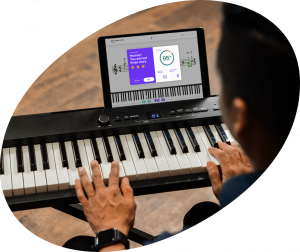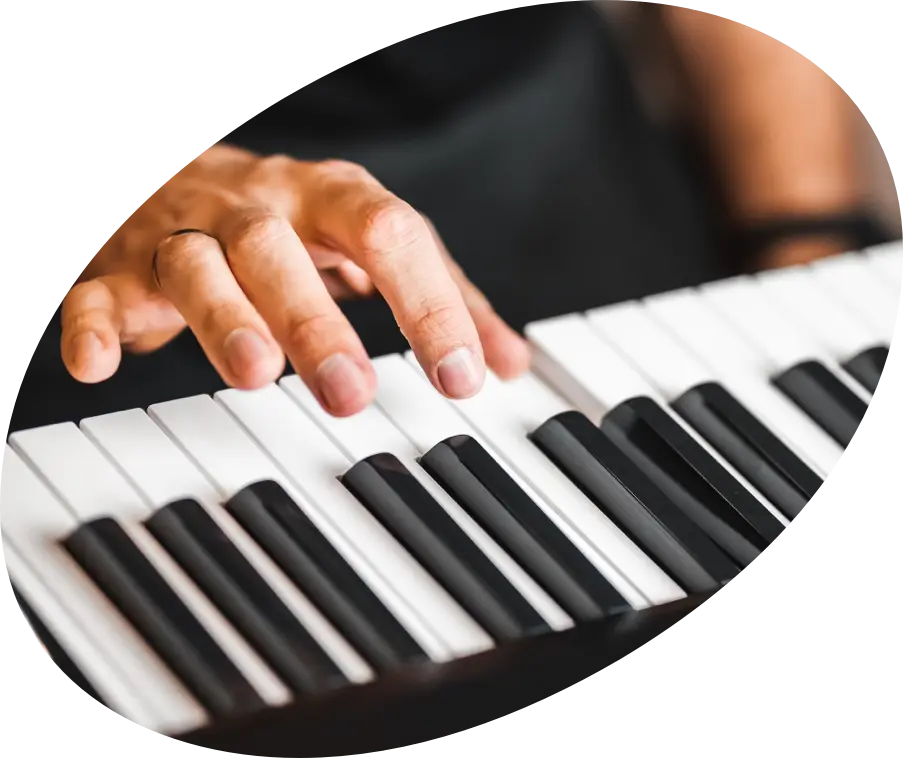Learning by playing
Learning to play songs on the piano is an excellent way to develop your skills. To be a musician, you need to play music, not just drills and exercises! While there’s value to learning how to read piano sheet music and learning piano basics, this knowledge should always be applied with real songs. From the very first day of your piano journey, you should experience the joy of playing real music. Whatever you know about music right now is enough to dive in. You can, and should, use your ears to guide you.
To help you learn by playing, we’ll discuss some fun songs to learn on piano. We’ll also review a chord progression that fits with many well-known melodies, and wrap up with some practice tips for learning faster and more efficiently.
Easy piano songs for beginners
Think of a melody you already know by heart. It could be a simple, beautiful song melody like “Lean on Me”, a ditty like “Happy birthday”, or a lullaby like “Twinkle twinkle little star.” These all count as real music! They’re good beginner piano songs because you already know what they’re supposed to sound like. You can try learning them by ear, without any sheet music.
Let’s take the first verse of “Lean on Me” as an example.
To warm up your inner musician, take a few minutes to try out these vocal exercises:
- Imagine how the song sounds using your inner ear. Which parts are clearer? Which are fuzzier? Can you imagine what it sounds like on the piano, or even with a different instrument?
- Now sing it like you normally would. How does it match up with what you imagined? Are there any surprises?
- Try singing it again without words, so that you can focus on how the melody moves up and down. Is each note higher or lower than the note before? Can you hear the difference, or feel it as you sing?
Now that you have the song firmly in your ear and your mind, you’re ready to start bringing it to life on the piano:
- Find Middle C (or really any C) on the keyboard. This is where the melody starts. Play it once (for “Some…”).
- Try to find the notes for “…times in our lives” on your own, by ear (hint: play C again, then the white keys to the right in order: D, E, F). It’s okay to make mistakes: in fact, if you hear a mistake, that’s a good sign, because that means your inner ear knows what the right note should sound like.
- Now do the same for the notes in “we all have pain” (hint: walk back down the white keys: F, E, D, C).
(A hint for all the melodies I mentioned is that you can play them all using just the white keys. Incidentally, this is true for “Chopsticks” as well.)
Beginner Classical piano songs you should learn
Now think of a classical piano melody you recognize. For instance, consider Beethoven’s “Ode to Joy”. Just as with the melodies above, you can play this by ear.
- First, find a recording and try singing along; you may also want to look up the lyrics, so that you know the meaning of the words you’re singing!
- Then, try all the steps we mentioned above: imagine what the music sounds like in your head; sing and hum the melody on your own; work through the melody note-by-note on the keyboard. Remember that you always have the recording as a reference if you get lost or stuck.
In this case, and especially for more complicated classical melodies (say, “Für Elise”, or Pachelbel’s “Canon in D” after the first few variations) some sheet music or a piano tutorial will be helpful. For pieces such as Chopin’s Prelude No. 7 in A Major and Bach’s Prelude in C Major from the Well-Tempered Clavier, sheet music becomes essential, because chords are such an integral part of the piece (and these can be challenging to figure out by ear).
What are common piano chords?
Just as it’s worth learning some familiar melodies when beginning piano, it’s also worth knowing some common chord patterns. We’ll focus on these four simple chords that you can play with your left hand:




Give it a shot. Sound familiar? You already know what this chord progression sounds like, even if you haven’t tried to play it before. It turns out that these chords, looped over and over, makes up the harmony of many famous songs. Try playing along with the Beatles’s song “Let It Be”, Alphaville’s “Forever Young”, or Taylor Swift’s “Out of the Woods”. Other songs use the same chords but in a different order, or transposed to a different key, but that’s a story for a different blog entry.
As with the melodies, the chord patterns will sink in quicker if you practice them along with recordings, or while singing along.
Practice tips to learn faster
Any of the techniques we described in this post are helpful for learning music theory and how to practice piano in a quick and effective manner. To summarize:
- Trust your ears! Start by trying to play songs and melodies that you already know.
- When you pick a song or melody to learn, try singing it before you play it on the piano.
- Play along with recordings, and while singing or humming along.
- Use simplified sheet music when it’s available. You may find it helpful to use a piano app like Playground Sessions, which has a song collection featuring piano arrangements at all different levels.
- Don’t be afraid of learning some music theory and reading skills, but use these to support your listening skills! Again, to practice reading music, you may find Playground Sessions helpful, because it shows you clearly whether or not you’re playing the notes in the sheet music. It’s also designed with gaming elements to help you learn faster.
Pick a song and start learning today! It’s worth it.

